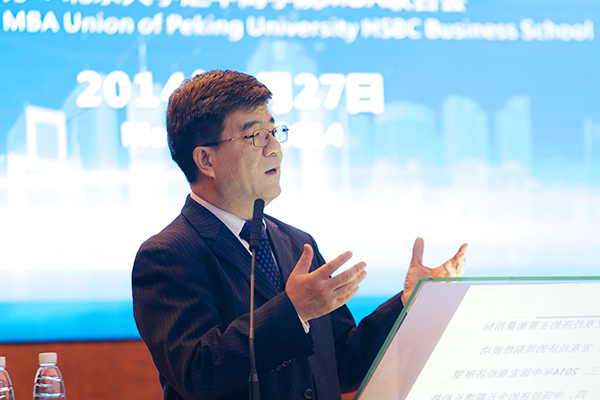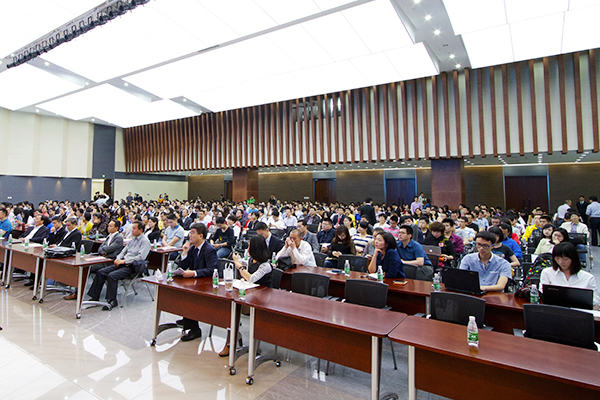Peking University, Mar. 31th, 2014: On the afternoon of March 27th, the first lecture of Peking University HSBC Business School (PHBS) 10 years Anniversary Lecture Series was held in the lecture hall of PHBS new building.
Sponsored by PHBS and Western Returned Students Association of Shenzhen, co-organized by PHBS MBA Association, the lecture attracted nearly 1000 people from various circles, including association members, returned talents, local government agents, local enterprise representatives, media staff and PHBS students.
Professor Hai Wen of PHBS, based upon the recent discussion on China Development Forum (2014) and his in-depth study of China's economic, gave a lecture on "China's Economy in 2014 and Future Expectation".

Professor Hai was delivering his speech.
As the president of Shenzhen Western Returned Scholars Association and the dean of PHBS, Hai Yan introduced to the audience that the Association, having a history of more than 100 years, had been undertaken the historical mission of serving the country with honor.
"2014 is the tenth year since PHBS was established," Professor Hai said, "and the school would always dedicate to the development of high education of Shenzhen and the improvement of entrepreneurs, and assist local enterprises in marching towards the world."
Focused on the analysis of China's economy in 2014 and its medium and long-term growth, the lecture is divided into four sections -- the key indexes in macro-economy, cyclical macroeconomic fluctuations, the outlook of 2014 China's macro-economy and the medium and long term growth trend of China's economy.

Four Key Macro-economic Indexes
For starters, Professor Hai briefly introduced macroeconomic indexes like GDP, CPI, unemployment, equilibrium of balance of payments and so on, spiced with social hot spots, historical events and some stories about seminars he ever attended.
Then he discussed the fluctuations of China's economy in recent years, concentrating on the historical background of China's economy as well as the major internal factors and external shocks which impacted on macroeconomic fluctuations.
When talking about the prospect of China's macroeconomic situation in 2014, he held that the governmental core control index of 2014 was more reasonable and realistic than those of past years and believed that the government would carry on implementing prudent monetary policy and proactive fiscal policy. "But governmental policies are only subsidiary," according to Hai, "since economic market should rely on its own force rather than external control."
As for China's medium and long-term economic development, Professor Hai Wen explained the definition of "high speed" in China's economy. He thought it was rational to predict the high speed of service industry in the next ten years would reach 7%.
"China's economy still had the possibility to keep increasing at the speed of 8% in medium and long term, because China was still on the take-off phase." Hai explained. Meanwhile, he cited the 8% high-speed development of Taiwan in 1961-1997 and Korea in nearly 38 years to support his point of view.

The audience was listening to the lecture.
As commenting on the strategy of our new central government of taking urbanization as a vital breakthrough of development, professor believed that urbanization would foster the growth of industries such as environmental protection, energy saving, retailing and health care.
A great deal of rural population, swarming into urban areas, could provide huge consumer markets for the cities. Meanwhile, Professor Hai indicated that, during the process of marketization, GDP calculation would gradually incorporated the value of goods and services, which had been excluded from the diagram.
At the end of his lecture, Professor Hai showed great faith in China's future progress. He encouraged the audience to seize opportunities for career development and academic pursuit, for our time was the greatest in Chinese history.

Written by: Wang Yawen
Edited by: Li Wenrui
Source: PKU HSBC Business School News